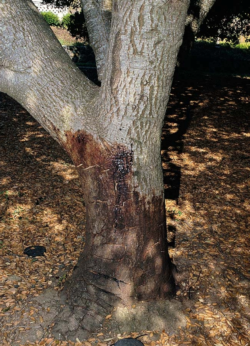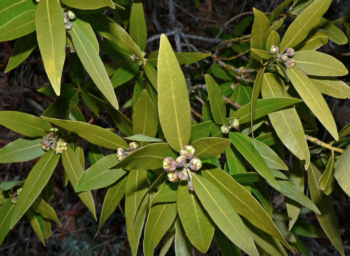Sudden Oak Death: a million trees gone and counting
-
Sudden Oak Death (SOD) is a devastating plant disease caused by Phytophthora ramorum, a pathogen that thrives in cool, moist climates. A relative of the pathogen that caused the deadly Irish potato famine, the SOD pathogen was introduced to California landscapes in the 1980s on imported, infected ornamental plants, most likely rhododendrons and camellias. Since then, SOD has killed more than a million California oak trees and infected more than 100 species of plants1.
Scientists have discovered that SOD is most often transmitted to oaks from nearby infected California bay trees. The pathogen drips onto oak trunks from the bay trees when it rains, enters tiny openings in the bark, and then proceeds to kill cells and clog water and nutrient transport tissue. In addition to being spread by bay trees and other host plants, SOD is also spread by soil and water. There is no cure for an infected oak. The most reliable early symptom of sudden oak death is dark sap exuding from the trunk. (Photo: UC IPM)
The most reliable early symptom of sudden oak death is dark sap exuding from the trunk. (Photo: UC IPM)Diagnosing SOD can be challenging because the symptoms are similar to those caused by other fungi, insects, or adverse conditions. The only way to be sure a tree is suffering from SOD is to have a sample analyzed in a laboratory. In general, infected oaks bleed red sap from the trunk as the pathogen cuts off nutrients and water until the oak dies. The most commonly infected oak species include coast live oak, California black oak, shreve oak, and canyon live oak. Tanoaks are also highly susceptible to lethal SOD infection.
SOD: why does it matter?
Oak trees are a critical component of the California landscape, from both a visual and ecological standpoint. There are 20 oaks native to California, shading the hot hillsides and edging the cool coastline. One single oak tree houses over 700 insect species and a multitude of birds and other wildlife. Even in our own backyards and neighborhoods, oaks help keep the balance of good bugs and bad bugs in check. If properly cared for, these majestic trees can live hundreds of years. While much research is still needed to determine the ecological impact of SOD, any massive die off of oaks will radically change our forest ecology, alter the landscape of our beloved Golden State, and increase the risk of wildfire.SOD increases as weather extremes worsen
Trained volunteers have conducted SOD “blitzes” every spring since 2008. During these data-gathering days, citizen scientists tag suspect bay trees, record GPS locations, and bag leaf samples for the UC Berkeley Forest Pathology Lab. Because consistent monitoring is pivotal to unlocking the clues that will help scientists manage SOD, the work of these volunteers is critically important. Recent results from the blitzes show that SOD infection rates go up in years with high rainfall and warmer temperatures. In 2016, more than 14,000 trees were surveyed. The infection rate in Marin rose almost 30% -- from 7.9% trees infected in the prior year to 10.2% in 2016. After our record-breaking rains in 2017, the SOD blitz surveys documented a three-fold increase in overall infection rates since the drought ended in 2015, with 13% of samples found positive. This is the highest infection rate seen since the blitzes began. Here’s where you can learn more about the findings of the SOD blitzes. The California Bay tree is a primary host plant for spreading the SOD pathogen to oaks. The evergreen tree grows to 75’ tall. (photo: GardenSoft)
The California Bay tree is a primary host plant for spreading the SOD pathogen to oaks. The evergreen tree grows to 75’ tall. (photo: GardenSoft)
Steps to prevent SOD
If you’re a Marin resident concerned about SOD, the California Oak Mortality Task Force suggests looking to see if bay or tan oak trees are present in your neighborhood near susceptible oaks. Research shows that the greatest predictor of identifying the Phytophthora ramorum pathogen on an oak tree is the presence of California bay laurel. Although there is no known foolproof way to prevent SOD, there are a few measures that may reduce risk2:• Avoid infested wildlands, known SOD areas, and muddy soil during rainy weather.
• Don’t collect or transplant host plant material from infested or quarantined sites.
• Keep vehicles on paved surfaces during wet weather.
• If you do enter an infested area during wet weather, scrape off any mud, soil, leaves, or other organic material from yourself as well as your pets and vehicle.
• Avoid doing yard in rainy weather, including pruning or grading
• Amend the soil around the base of an oak 3 feet out from the trunk every two years with 3 to 5 pounds of granular gypsum (calcium).
• Consider hiring a qualified arborist to treat susceptible oaks with a phosphonate fungicide annually.How you can help
Become a citizen scientist! Funded by the US Forest Service and the UC Berkeley Pathology Lab, the SOD blitzes depend on all of us to gather data. It’s an easy activity suitable for people of all ages – an excellent way for families and schools to contribute to an important environmental cause. In addition to helping unlock the mysteries of this deadly scourge, you will also play a role in saving one of California’s horticultural treasures.For more information, visit the UC Integrated Pest Management SOD webpage.
By Marie Narlock1 http://ipm.ucanr.edu/PMG/PESTNOTES/pn74151.html
2 http://www.suddenoakdeath.org/diagnosis-and-management/sanitation-reducing-spread/


